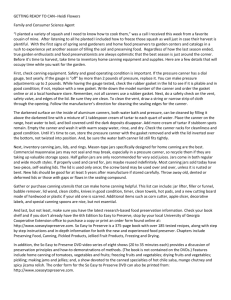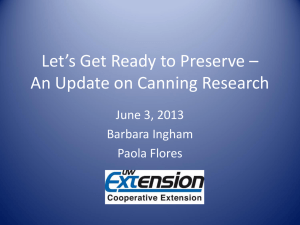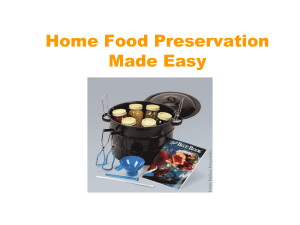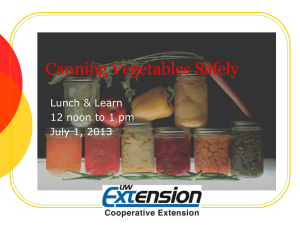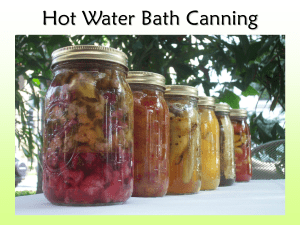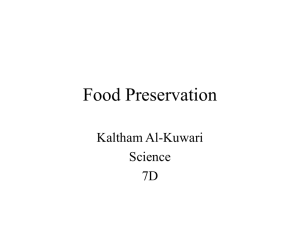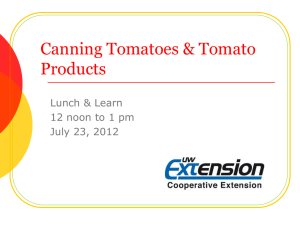Master Food Preserver Training
advertisement
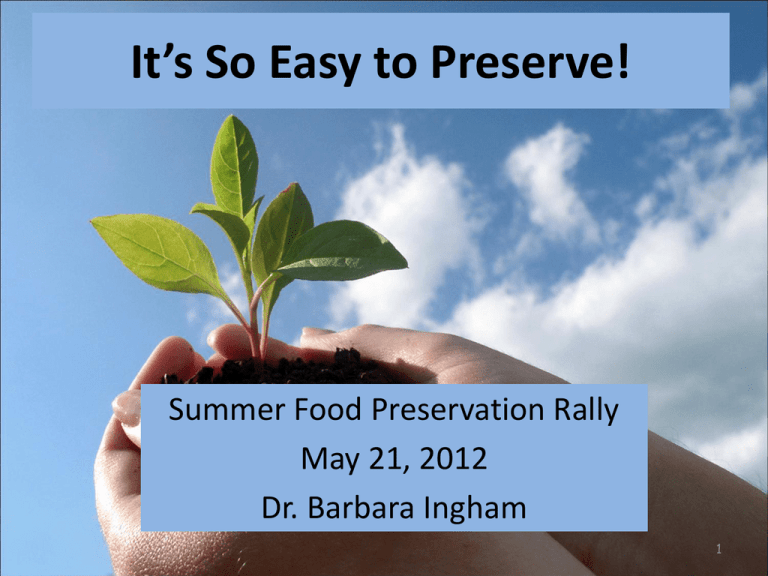
It’s So Easy to Preserve! Summer Food Preservation Rally May 21, 2012 Dr. Barbara Ingham 1 University of Wisconsin-Extension: Your trusted source for food preservation information and training (2005) A study by the National Center for Home Food Preservation (Univ. of Georgia) indicated a need for home food preservers to update their canning practices • About 20% of households nationwide preserve food at home • Canning instructions come from family or friends (51%) and cookbooks (17%) • Of those canning, 30% admitted to altering recommended procedures • Even experienced canners use open-kettle canning to can fruit and tomatoes, vegetables and meats or seafood 2 Home Preserved Food Our aim: safe, high quality home preserved food. 3 Annual Cases of Foodborne Illness Cause of Illness Bacteria Parasites Viruses Unknown agent # Cases 3.6 million 232,705 5.5 million ~38.4 million # Deaths 861 333 157 1,686 (56%) •48 million foodborne illnesses each year •128,000 hospitalizations •3,000 deaths •Economic loss is$5 billion dollars!! CDC, Dec. 2010 Outbreaks of Foodborne Illness 5,316 outbreaks of illness linked to specific foods occurred between 1990 and 2005 FOOD Seafood # OUTBREAKS 1,053 # ILLNESSES 10,415 Produce Poultry Beef 713 580 506 34,049 17,661 13,873 Eggs 352 11,224 CDC, 2008 News Headlines….. •(2008) FDA finds Salmonella strain on jalapeno peppers; 1,442 Americans sickened •(2010) 10 illness and 5 deaths linked to Listeria- contaminated celery •(2011) 125 cases of salmonellosis linked to alfalfa and mixed sprouts from Tiny Greens Organic Farm (IL); 3 ill in Wisconsin •(2011) 146 people were infected after eating Listeriacontaminated cantaloupe; 30 deaths were reported Fresh produce is increasingly linked to foodborne illness outbreaks! 6 Botulism Strikes Spokane Mother, Two Children February 28, 2009 …The Associated Press reported that three people in Spokane, Washington, have become ill from botulism. The botulism apparently occurred from improper canning techniques used in home-canning of green beans vegetables from a private home garden. The woman was a nurse in her 30s with two children under ten. She became ill enough to be put on a ventilator; the children suffered milder symptoms. The incident was linked to difficult economic times. 7 Getting Started…Recipes • Use ONLY up-to-date, research-tested recipes! Current canning instructions date from 1994 • Don’t (necessarily) do what Mom told you! • Leave creativity behind (when home preserving) • National Center for Home Food Preservation – www.uga.edu/nchfp/ • Food Safety & Health www.foodsafety.wisc.edu • Ball www.freshpreserving.com 8 Getting Started…Produce • Start with tested varieties • Harvest at the proper maturity • slightly under-ripe or peak of ripeness • never try to save rotten produce or produce from dead plants by preserving • Discard diseased produce (especially important in canning and drying) 9 Cleaning Produce • ‘Wash’ produce with clean water; do not use soap. Produce rinses such as FIT® have not been proven to be effective. • Water should be warmer than fruit by at least 10°F to prevent infiltration of microbes. • A dilute chlorine dip can reduce chance of contamination remaining on rinsed produce. [Use ½ - 1 Tablespoon unscented bleach per gallon of water.] Getting Started…Supplies Whether canning, freezing or drying foods, start by: Inspecting jars and purchasing new 2-piece lids Purchasing freezer containers – proper packaging is key to preventing freezer burn Cleaning and testing your dehydrator - dehydrators should have a temperature control and fan to remove moist air 11 Getting Started…Canners Boiling Water Canners • Use for high acid foods (most fruits) or acidified foods (pickles, salsa) • A rack is needed to lift jars off the bottom • Use with a tight-fitting lid • Processes food at 212°F 12 Getting Started…Canners Pressure Canners • Use for low acid foods (meat, vegetables) • Dial gauge – checked every year for accuracy • Weighted gauge – inspect gasket and vent port • Fitted with a rack • Processes food at 240°-250°F 13 How do we know which canning method to use? What is the pH (acidity) of the food? below pH 4.6 above HIGH Acid Boiling Water Canning Fruits, Pickles, Salsa LOW Acid Pressure Canning Meat, Vegetables 14 What is ‘magic’ about pH 4.6? 1.IF the pH of the food is above 4.6 2.IF there is no oxygen present 3.IF the temperature is warm Clostridium botulinum can grow and produce TOXIN (botulism poisoning) 15 ‘Recipe’ for Danger 1 Food, pH above 4.6 (meats, vegetables, improperly acidified tomatoes, pickles) 1 Vacuum sealed canning jar (oxygen is removed) 1 Room @ standard temperature ADD: C. botulinum spores WAIT! You don’t need to add these, they are everywhere! Conditions for neurotoxin production: • Spores of C. botulinum • No oxygen • pH greater than 4.6 Growing cells produce TOXIN 17 What does this mean for home canning? Foods with pH above 4.6 that you want to can: Process in a pressure canner to destroy spores of C. botulinum. Adding pressure increases temperature At sea level, water boils @ 212°F 10 pounds pressure (psi) - 240°F 15 pounds pressure (psi) - 250°F ‘Newer’ Foods Linked to Botulism Poisoning • Improperly cooled foil-wrapped baked potatoes or grilled onions • Improperly fermented ethnic foods • Improperly acidified garlic-in-oil • Watermelon jelly (March, 2011) • Unrefrigerated potato soup (April, 2011) In Europe, 477 cases from 2006-2008 o Olive tapenade, almond-stuffed olives, curry sauce In U.S., 263 cases from 1990-2000 19 What affects canning besides pH? • Pack method – raw pack or hot pack • Jar size – half-pints, pints or quarts • Elevation - affects boiling point of water Tomatoes, whole* Boiling water canner – 85 minutes Dial gauge canner - 25 min @ 11 psi Weighted gauge - 25 min @ 10 psi *hot pack, Qt. jars, 1,000 ft. p. 15 Tomatoes Tart & Tasty 20 Tips for Successful Canning • • • • Properly pre-treat jars and lids Fill jars with hot liquid (never cold!) Leave the proper headspace Boiling water canning: jars must be covered with 1-2” of boiling water during processing • Pressure canning: vent canner for 10 minutes before pressurizing • Adjust for elevation 21 The RULE of Canning A sealed jar ≠ A safe jar 22 Don’t harm your family with these canning methods! • Boiling water canning of lowacid foods (meats, vegetables) • Open-kettle canning (filling the jar, putting lid on…and you are done??) • Dishwasher canning • Oven canning 23 Don’t Forget • Process at the correct temperature (boiling water canning for fruits and acidified vegetables; pressure canning for meats and vegetables) • Adjust for elevation above 1,000 feet (extend processing time for BWC, increase pressure for PC) • Follow an up-to-date, research tested recipe *Note: darker areas on the state map have an elevation above 1,000 feet. Increase time when boiling water canning; increase pressure when pressure canning. 24 And now a word about…canners vs cookers Pressure canners and pressure cooker are NOT necessarily the same thing. •Pressure canners must hold at least 4 Quart jars and be able to regulate pressure at 5, 10, 15 pounds (psi). Pressure cookers are NOT recommended for home canning. 25 Canning and Preserving for Special Diets • Choose recipes that don’t require sugar or salt for safety • Read the recipe carefully • Don’t choose your own substitutions see www.uga.edu/nchfp/ (National Center for Home Food Preservation at the University of Georgia) 26 Home Canning Resources • Using & Caring for a Pressure Canner(B2593) • Wisconsin Safe Food Preservation Series (2008): canning fruits, salsa, vegetables, meat, tomatoes, pickles & jam (www.foodsafety.wisc.edu) • Ball Canning www.freshpreserving.com/ • National Center for Home Food Preservation (www.uga.edu/nchfp/) *Resources from 1994 or later! 27 Tips and Tricks of the Trade Don’t you just love those FAQs! • Can I ‘can’ on a glasstop stove? • What is the best way to keep my jars hot before filling (and canning)? • How do you pretreat lids for canning? • What type of pressure canner is best, weighted or dial gauge? • Is there an easy way to make low-sugar jam? 28 FAQ Answers Problem: Smooth-top ranges require a smooth-bottomed pan or kettle. The canner can not extend over the burner by more than 1-inch. Solution: Use a canner with an ‘outset’ bottom. Problem: Jars must be kept hot before filling, and after filling before canning. Solution: Use a roaster with 2-3” of water to keep jars hot. Add vinegar to prevent hard water strains. 29 FAQ Answers 2 Problem: How do I chop all those vegetables and fruits for my salsa? Solution: Try a chopper or blender! Problem: How do I manage to keep my lids and bands ready for when I need them? Solution: A mini crock pot and potato masher! 30 ‘Secret’ Ingredients • What is ClearJel and how do I use it? ClearJel is a modified corn starch used in pie fillings – it will stand up to the ‘triple threat’: heat in preparation, canning, and ultimately cooking into a pie. Flour or corn starch gel will break down on canning. ClearJel is also sold as Permaflow. ‘Instant’ ClearJel will gel without heat and is used for gravies, cream pies, and bakery fillings (not canning!). 31 Changes in viscosity during heating, holding and cooling of starch pastes. Ref.: Foods: A Scientific Approach. 1998. H. Charley & C. Weaver. 32 Pectin versus ClearJel • Pectin = plant fiber; used to create a gel when making jams, jellies and fruit preserves – Powdered ≠ Liquid – Not used interchangeably – Purchase powdered in bulk, using generous 1/3 C. bulk / box • ClearJel = plant starch (modified); used in pie filling or NEW! in low-sugar jams or doubled jam recipes 33 What Type of Canner to Buy? Weighted Gauge Canner • Measures pressure at 5, 10, 15 pounds. • No need to test annually. • You can hear it, but you don’t necessarily know if its pressurized (handle locks). • Adjustments only in 5-pound increments. Dial Gauge Canner • Dial tells you the exact pressure inside. • Check every year for accuracy, even if new! • Easily adjusts for elevation. • Some are ‘double tall.’ • A word about All American 34 A weighted gauge canner with a dial! What Type of Canner to Buy? Weighted Gauge Canner • Measures pressure at 5, 10, 15 pounds. • No need to test annually. • You can hear it, but you don’t necessarily know if its pressurized (handle locks). • Adjustments only in 5-pound increments. Dial Gauge Canner • Dial tells you the exact pressure inside. • Check every year for accuracy, even if new! • Easily adjusts for elevation. • Some are ‘double tall.’ • A word about All American All American Brand of canner. 35 Times Change… Home Canning Updates • Add acid to all tomato products. • Alum is no longer recommended to firm pickles (if used, for crock pickles only). • Lime (calcium hydroxide) is used only as an initial soak to firm pickles; remove excess by rinsing. • For firm pickles – pickle fresh cukes, remove 1/8” from blossom end, pack cukes in ice, use CaCl2 (pickle crisp). • Do not use paraffin to seal jars of jam & jelly. • Jar lids must be single use; seal finger-tip tight before processing, remove bands after processing, clean/dry and replace. 36 Don’t Need Diamonds? Try a Steam Juicer (Mehu Liisa~$200) or a Telescoping Magnetic Pick Up (~$5.00) 37 Join the Fun this Summer Summertime Lunch & Learn Series UWEX County Extension Offices 12 noon – 1 pm Monday, June 4 •Planning for a Successful Food Preservation Season •Making Jams and Jellies Monday, June 25 Canning Vegetables Safely Monday, July 23 Canning Tomatoes and Tomato Products Monday, August 6 •Time to Make Pickles! •Canning Fruits Safely Monday, August 20 Drying Foods at Home 38 Happy Preserving! 39
